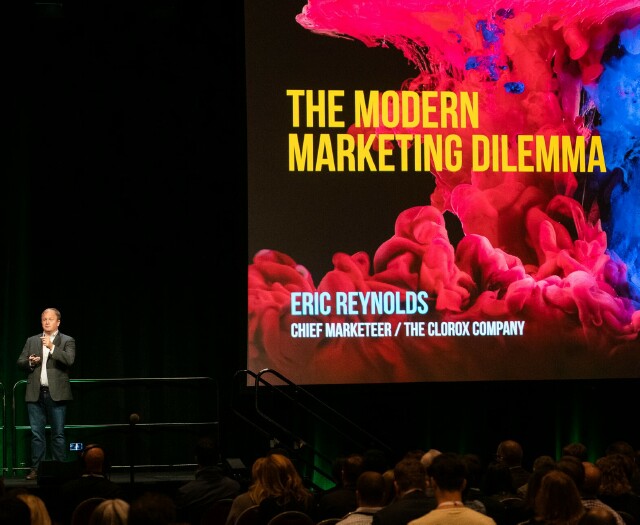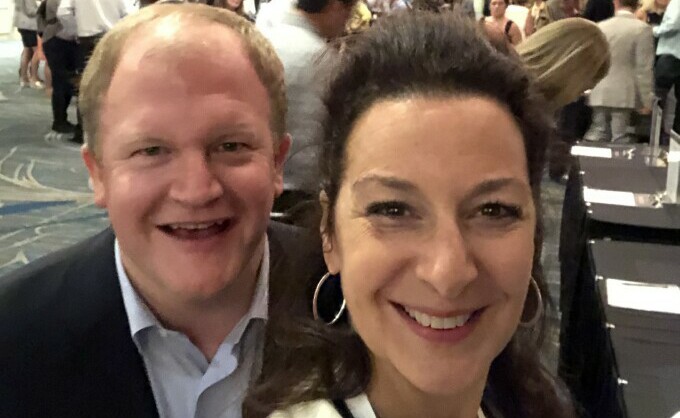Podcast: Clorox CMO Eric Reynolds on Balancing Influencer, Performance and Classic Brand Marketing

How does a CMO for a company with some twenty top brands create an emotional connection with consumers and still succeed with performance marketing? In this episode of Insider InSites, Eric Reynolds, Chief Marketing Officer of The Clorox Company tells all -- from how he taps the world of influencers to his strategy for voice ... and, of course, whether or not Clorox really removes wine stains! The following has been edited for length and clarity; listen here for the full conversation on staying ahead of the marketing curve at a hundred-year-old company and how to compete with challenger brands like Jessica Alba's Honest Company.
E.B. Moss (pictured below with Reynolds): Eric, you have global responsibility for all marketing functions -- brand strategy to personnel, media buying to advanced analytics -- at The Clorox Company. That ranges from Clorox Bleach and Lysol to Burt's Bees and Hidden Valley Ranch Dressing. How do you create an emotional connection with such diverse [products and] customers?
Eric Reynolds: You've got to make an idea that connects with the head and the heart, that's relevant for the category and the brand, but also to that person. That takes a lot of hard work, insight and getting that tonality right. People, particular younger consumers, want to feel like they understand the values and the ideas and the beliefs of the brands they buy. So, we work really hard to bring that to life through all kinds of storytelling.
Moss: You recently spoke at ANA Masters of Marketing about influencer marketing (photo at top). What's your approach?
Reynolds: We have found time and time again that influencers are a bigger piece of our marketing mix because having other trusted people tell our brand's story is essential to getting the word out. We have increasingly found influencers essential to our overall strategies for keeping our brands fresh and relevant. Because guess what? People want to hear about our brands from people that they feel like they know and trust, and they put a lot of weight on those messages. Whether it's a big celebrity influencer or micro-influencers really depends on the brand, the question, the strategy.
[As a celebrity example] Steph Curry of the Golden State Warriors came to us because he was so committed to people using less plastic in drinking water. He could have signed a big sugary beverage contract with almost any major manufacturer, but he said, "No, I believe in Brita." He's been an outstanding spokesperson and he particularly talks to that younger Brita user we're trying to bring to the franchise to lure them into filtered water. That's an example where his personal passion and the brand passion connect. We've used him in social videos and YouTube and it's been great.
And could anything be more everyday than Liquid-Plumr? We found influencer work through creators making videos about gross stuff getting clogged is an exceptional way to get people to engage in the category. They've been putting up this incredible content, the organic views have been incredible, and it's been so strong we're taking influencer-generated content and putting it on TV. In the old days it would have been [the other way around].
Our main channels still continue to deliver beautifully but a lot of our spend and focus is digital video, which [has become] terribly important to tell our story across most of our brands. And the ability to reach people in search at the moment of intent has grown, but the new channels are Amazon, Target, Walmart, where it's not just a place to buy, but a place to tell our story. Amazon is a media platform.
Moss: How are you grappling with smart speakers and that type of shopping?
Reynolds: We're watching the voice trend and participating in its development very closely. Consumers go to things that are easier and faster and better and voice is a way to do that. Early on, we're quite lucky because most of our brands are either No. 1 or No. 2 in their categories and they have top-of-mind recall with the consumer.
Moss: I ask for Clorox. I don't ask Amazon or Alexa for bleach.
Reynolds: Yes. Or, if you say "bleach," because the algorithm knows we overwhelmingly win purchases of branded bleach on Amazon, Amazon will make us the first choice.

(Reynolds goes on to explain how their approach to brands has to be holistic -- from package design that reads well on Instagram or ships via Amazon more sustainably -- and considers the total consumer experience versus just "the goo in the jar." New tools range from AR to chatbots, to predicting areas of flu outbreaks via aggregated healthcare data in order to encourage retailers to stock up on Clorox. Next, he describes balancing classic brand marketing and performance marketing.)
Reynolds: I'd argue that [classic brand marketing and performance marketing] both have something to offer to consumers to build modern brands. For us, we're finding the perfect balance is 60% classic brand marketing and roughly around 35-40% what we call activation -- or the things that performance marketing tends to care about. When we get that balance right between those two things we see ourselves having the best returns. If it's too much about just "the clicks and the data" or "performance marketing is so great" we lose track of the competition, we lose a real sense of who the consumer is, and we definitely lose the brand.
But if we're just talking big brand stories, consumer generalizations, we're missing that consumer intimacy that we need to bring because the consumer can leave us in two seconds. We have to remind them from the big messaging all the way down to that moment of activation that we are their perfect choice. I would say that the spoils would go to the marketers that figure out how to do this well. We're still learning; we have new tools to get it done right, but we think we've hit on the right problem to solve.
Moss: The ANA reported that 78% of brands have in-house agencies. What have you taken back more in-house than you might have before?
Reynolds: We've probably had an in-house agency for 20 years, but what has changed is the mix of the work they do -- making more of that disposable or at least short-lived content as more and more content is required of brands as they try to speak one-to-one to people. Most of that is digital content for social purposes, although we can make film and other sorts of things.
Moss: When it comes to social, do you have any projections as to what's next?
Reynolds: I don't think there's a lot new actually in the platforms. I think we're learning how to use them better. We get really excited about the storytelling capabilities of Instagram and of course all the data and insights that come with that. The big trend now is using what we have better and more effectively. Our focus is on using data to be better storytellers rather than looking for the next social platform. We've matured past being on platforms for the sake of being on them. Now we're stepping back, saying, "How do we use these platforms for real brand building?" Facebook, Google and others are getting good at listening to us and making changes to their platforms that are beneficial to us.
Moss: Trust is an issue for brands, and authenticity has to come shining through. How are you working to spotlight social responsibility, which I know is also personally important to you?
Reynolds: I think it's a great privilege to be a brand builder. People take hard-earned money out of their wallets and they choose our products to do something useful for them, and there's an expectation that our products work. There's also an expectation that we use the data that comes from that responsibly. We believe a brand should stand for values that matter to others, too ... that a brand is an idea and it has to fight for something beyond just being a product. Advancing values where people feel they are seen and heard is our job.
Now, as a company with lots of resources and employees, we're absolutely accountable to civil society. If we are an inclusive, fully representative company, we can serve people who are in fact no different than the people who work in our company. If we don't look, feel and act like, in this case, the American population, then why would consumers put their faith in us in the long run? It all fits together. Social responsibility. Values. Inclusion and diversity. These are all essential to the long-term health of our company and our brands.
Moss: Finally, I happen to know you're an oenophile, so does Clorox get wine stains out?
Reynolds: We go to Napa a lot and the Clorox Bleach Pen is exceptional at getting wine stains out!
Photo credit: ANA
Subscribe to all Insider InSites episodes via Apple podcasts, Stitcher, Google Play or iHeartRadio.
Click the social buttons above or below to share this story with your friends and colleagues.
The opinions and points of view expressed in this content are exclusively the views of the author and/or subject(s) and do not necessarily represent the views of MediaVillage.com/MyersBizNet, Inc. management or associated writers.


